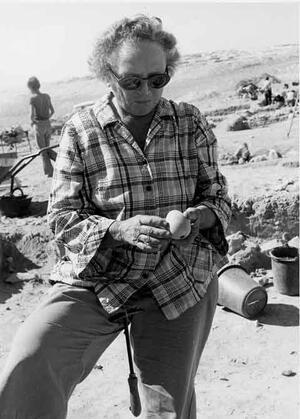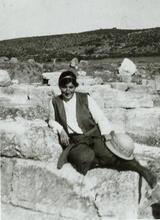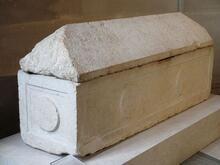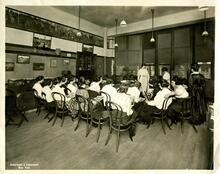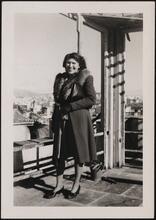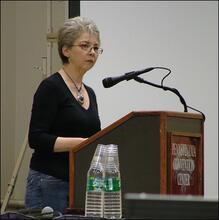Ruth Amiran
Ruth Amiran began studying archaeology at Hebrew University in 1935. In 1948 she became supervisor of artifacts in the Galilee for the Department of Antiquities in the newly established State of Israel. She led excavations at tombs and cities throughout the country. Her most noted dig took place at the Bronze Age city of Tel Arad, where she uncovered details about daily life in an urban center in the south of Israel. Beginning in 1965 she helped plan the Israel Museum and was later appointed curator and field archaeologist of its archaeological wing. Amiran also studied ceramic artifacts, and her 1970 book Ancient Pottery of the Holy Land became the standard textbook for the field. She won the Israel Prize in 1982 for her contribution to the field.
Education and Early Career
Born and raised in Yavne’el in the Lower Galilee, Ruth Amiran (née Brandshteter) graduated from the Reali School in Haifa. In 1935 she began to study archaeology at the Hebrew University of Jerusalem, earning an M.A. She married David Amiran (1910–2003), a professor of geography at the Hebrew University of Jerusalem. The couple had no children.
Amiran began to participate in archaeological digs during her studies. The first of these, at the city of Ai, was directed by Judith Marquet-Krause. The next excavation in which she participated, at Tell Jarisha, was directed by Professor Eliezer Lipa Sukenik (1889–1953).
In the 1940s she was employed by the Department of Archaeology at the Hebrew University. Later she worked at the Rockefeller Museum in Jerusalem and at the British Press Department, whose offices were also located in the museum.
Significant Excavations
When the state was established, Amiran went to work in the Department of Antiquities (which later became the Israel Antiquities Authority), where she served as the supervisor of artifacts in the Galilee and in Jerusalem and as the inspector of regional museums. In this position she directed archaeological surveys in the Galilee, the Negev and other areas of the country.
As an excavator in the Antiquities Department she directed various excavations in Tivon, Jerusalem, Sussita, Acre, and Rosh ha-Nikrah, sometimes in collaboration with colleagues. Some years later, she headed the excavation teams at Tel Kisioun, Tel Nagilah, the small Tel Malhata, Rosh ha-Ayin and at David’s Citadel, tombs and other locations in Jerusalem.
Amiran was part of the archaeological team at the Hebrew University of Jerusalem’s excavation of Tel Hazor (1955–1958) headed by Professor Yigael Yadin (1917–1984). This gave her a major opportunity to observe the conduct of a large excavation that included field work and the preparation and processing of artifacts for scientific publication—experience on which she later drew during the large excavation of ancient Arad, where she was responsible for Area B, in which a citadel from the Israelite Period was discovered. Her discoveries there, together with the team architect, led to an extremely significant scientific publication on the type of the Assyrian home with an Assyrian courthouse, which was discovered at Hazor and at other locations. Together with Professor Yohanan Aharoni, Amiran wrote an essay on the results of the excavations in her area and in the adjacent Area A which laid the basis for a redivision of the Israelite period.
In 1965 Amiran helped to prepare plans for the establishment of the Israel Museum. Upon its founding, she was appointed curator of the Bronfman archaeological wing of the museum. Her greatest contribution was the design and planning of the wing. Chosen as the wing’s field archaeologist, she served in that position until her retirement.
Amiran’s most important excavation during her work at the Israel Museum was at the early Bronze Age city of Tel Arad, where digs were conducted from 1962 to 1966, from 1971 to 1978 and from 1980 to 1984. The excavation of the site of the ancient city of Arad is an example of a methodical excavation carried out with the greatest patience and professionalism. It revealed a large, ancient city fortified with walls and semi-circular towers. The city contained a large reservoir system, a system of roadways, and private living quarters in which Amiran identified the typical Arad home of that period, calling it “the Aradi home.” The area also contained public buildings, including markets, a palace and a compound with twin temples. This was the most important and perhaps the only urban center in the south of the country to date. Amiran wrote two major reports on Arad once the excavations were completed.
Studying Ceramic Artifacts
The excavation at Arad led Amiran to concentrate on other major subjects in The Land of IsraelErez Israel archaeology, such as the relationship between Israel and Egypt during the urbanization period of the early Bronze Age, the ceramic artifacts of the period and more.
In dealing with ceramic artifacts, Amiran took upon herself an important field of study. Her first studies focused on the ceramics of the land of Israel during antiquity. She specialized in the unique ceramic artifacts of the site and the petrographic examination of the ceramic fragments (which indicate the source of the vessels), and she published research about the reciprocity and mutual influence between the ceramic vessels and history. The most prominent of her studies of ceramics is her basic work on Erez Israel ceramics during antiquity, from the Neolithic period to the destruction of the First Temple. In this book Amiran determined the division of types of ceramics according to period.
Another important study by Amiran concerned the connections between Erez Israel and Anatolia during antiquity. Her interest in the cultures of the neighboring lands resulted in the publication of studies of ceramic artifacts, stelae, and other objects from neighboring lands such as Egypt, Mesopotamia, Cyprus, and elsewhere. Amiran also published scientific studies about water systems, concentrating mostly on the water supply of ancient Jerusalem.
An important project in her professional life was her participation in planning the Ceramics Pavilion of the Erez Israel Museum in Tel Aviv, where she prepared a coherent educational plan that included designing a reconstructed model of an Israelite home.
Amiran was renowned in the archaeological community also because of her close and special connection with important archaeologists who dealt with various cultures in the Middle East, particular in the Aegean area. She was awarded the Israel Museum’s Percia Schimmel Prize in Archaeology in 1981 and the Israel Prize in 1982.
Amiran died on December 14, 2005, in Jerusalem at the age of 91.
Ancient Pottery of the Holy Land: From Its Beginnings in the Neolithic Period to the End of the Iron Age. New Brunswick: Rutgers University Press, 1970
Ancient Arad: Introductory Guide to Exhibition Held at the Israel Museum, Jan.-Apr. 1967. Jerusalem: Israel Museum, 1967.
with O. Ilan and M. Sebbane. “Ancient Arad—An Early Bronze Age City on the Desert Fringe and the Arad Fortress” (Hebrew). In Arad, by R. Amiran, O. Ilan, M. Sebbane, and Z. Herzog, 105-109. Tel Aviv: Hakibbutz Hameuchad Publishing House, 1997.

